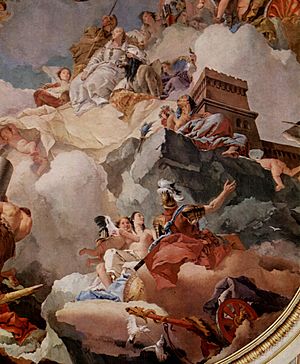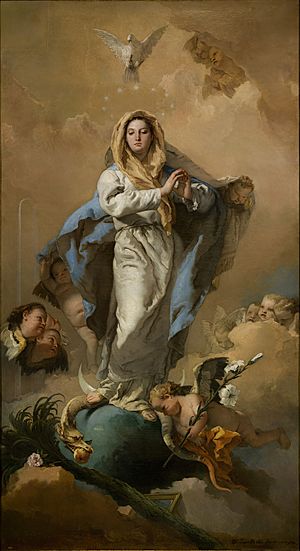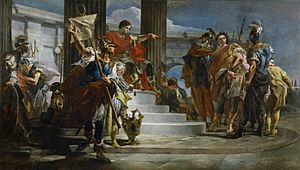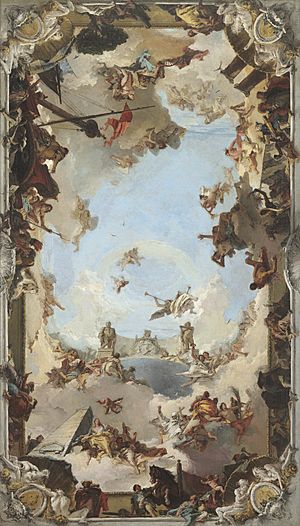Giovanni Battista Tiepolo facts for kids
Quick facts for kids
Giovanni Battista Tiepolo
|
|
|---|---|
| Born | 5 March 1696 |
| Died | 27 March 1770 (aged 74) Madrid, Spain
|
| Nationality | Italian |
| Other names | Gianbattista Tiepolo, Giambattista Tiepolo |
| Known for | Painting |
| Movement | Rococo |
Giovanni Battista Tiepolo (born March 5, 1696 – died March 27, 1770) was a famous Italian painter. He was also known as Giambattista Tiepolo. He came from the Republic of Venice and painted in the Rococo style. Many people consider him one of the most important artists of the 1700s in Venice.
Tiepolo painted a lot of artworks. He worked not only in Italy but also in Germany and Spain. He was very successful from the start of his career. An art expert named Michael Levey called him "the greatest decorative painter of eighteenth-century Europe."
Contents
About Tiepolo's Life
His Early Years (1696–1726)
Giovanni Battista Tiepolo was born in Venice, Italy. He was the youngest of six children. His father was a small shipping merchant. When Giambattista was about one year old, his father passed away. His mother then raised the family.
In 1710, Tiepolo became a student of Gregorio Lazzarini, a well-known painter. But Tiepolo also learned a lot by studying other artists. He looked at works by Sebastiano Ricci and Giovanni Battista Piazzetta. He also studied older Venetian painters like Tintoretto and Veronese.
A book about his teacher said that Tiepolo "embraced a quick and resolute style." This means he developed a fast and confident way of painting. His first known paintings were for a church in Venice around 1715–1716. He also painted for the Doge (leader) of Venice. In 1716, he painted his first fresco on a church ceiling. A fresco is a painting done on wet plaster.
Around 1719–1720, he painted frescoes for a rich publisher. He created amazing illusions of space in these works. This became a common theme in his art. In 1722, he was one of twelve artists chosen to paint for a church in Venice.
His Family Life
In 1719, Tiepolo married Maria Cecilia Guardi. She was the sister of two other Venetian painters. Tiepolo and Maria had nine children together. Four daughters and three sons grew up to be adults.
Two of his sons, Domenico and Lorenzo, became painters too. They worked with their father and later became famous on their own. Domenico was especially well-known. Tiepolo also taught other students, including Fabio Canal.
Important Works (1726–1750)
Tiepolo received many important jobs from wealthy families. One family, the Dolfins, hired him to decorate a chapel in a cathedral. He also painted scenes from the Bible at their palace. These paintings were bright and cheerful. Tiepolo used cooler colors than other painters. This helped him create a realistic daylight effect.
His first major works in Venice were ten huge paintings. They showed battles and triumphs from ancient Roman history. These paintings were very bright and new for Venetian art. They led to many more jobs for him.
He painted for churches and palaces across Italy. Some famous works include:
- Ceilings in Milan (1731)
- Paintings for the Colleoni Chapel in Bergamo (1732–1733)
- A ceiling for the Gesuati church in Venice (1737–1739)
- Decorations for the Palazzo Labia in Venice (1745–1750), showing the story of Cleopatra.
Etchings
Tiepolo also made two sets of etchings. Etchings are a type of printmaking. The first set was called Capricci (around 1740–1742). The second was Scherzi di fantasia (around 1743–1757).
The Capricci etchings often showed strange and imaginary scenes. The Scherzi etchings were made over ten years. They showed mysterious figures and scenes of magic.

Working in Würzburg (1750–1753)
By 1750, Tiepolo was famous all over Europe. He traveled to Würzburg, Germany, that year. He stayed there for three years. During this time, he painted amazing ceiling frescoes in the Würzburg Residence palace.
He worked with his sons on the Kaisersaal salon. Then he painted a massive fresco on the main staircase ceiling. This painting, called Allegory of the Planets and Continents, is huge. It shows the god Apollo and figures representing planets and the four continents. Tiepolo even included portraits of himself and his son in the painting.
Back in Venice (1753–1770)

Tiepolo returned to Venice in 1753. He was very busy with new projects. He was even chosen as the President of the Academy of Padua. He painted frescoes for churches, like the Triumph of Faith. He also painted for grand villas in the countryside, such as Villa Valmarana and Villa Pisani.
At the Palazzo Labia, he painted two famous scenes about Cleopatra. He also painted a ceiling fresco showing the Triumph of Bellerophon. He often worked with Girolamo Mengozzi Colonna, who designed opera sets. This made Tiepolo's frescoes look like staged plays.
His Time in Madrid

In 1761, King Charles III of Spain asked Tiepolo to paint a ceiling fresco. It was for the throne room of the Royal Palace of Madrid. The painting, Apotheosis of Spain, showed Spain's power around the world.
He also painted two other ceilings in the palace. He took on many private jobs in Spain too. However, he faced some challenges from another artist, Anton Raphael Mengs. Mengs was a supporter of a new art style called Neoclassicism.
Tiepolo passed away in Madrid on March 27, 1770. He is buried in Venice. After his death, the Rococo style became less popular. But Tiepolo's fame as a great artist never faded.
Gallery
See also
 In Spanish: Giovanni Battista Tiepolo para niños
In Spanish: Giovanni Battista Tiepolo para niños











